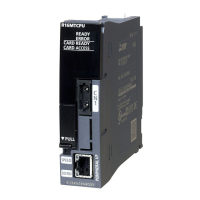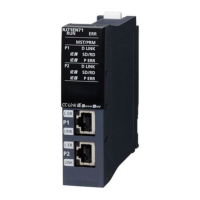94
4 AUXILIARY AND APPLIED FUNCTIONS
4.2 External Input Signal
4.2 External Input Signal
External input signals are managed as "external signals" or "high-speed input request signals".
External signals are used with control functions such as home position return, speed/position switching control, hardware
limits, and stop processing.
High-speed input request signals are used with control functions such as mark detection clutch control, and synchronous
encoder axis current value changes.
External signal
External signals (FLS signals, RLS signals, STOP signals, DOG signals) are assigned to each axis, and are used with control
functions such as home position return, speed/position switching control, hardware limits, and stop processing.
External signals are set in the external signal parameters.
Refer to following for details on external signal parameters.
MELSEC iQ-R Motion Controller Programming Manual (Positioning Control)
Signal type
• Bit device • Bit device
• Amplifier input DI3
• Bit device
• Amplifier input DI1
• Bit device
• Amplifier input DI2
• Bit device
Signal control
Control function
High-speed input
request signal
(64 signals)
• Compensation time
• Valid/Invalid
• Status
• Leading edge/
Trailing edge/
Both directions
• Precision settings
DOG signal
• Normal open/
Normal close
• Precision settings
FLS signal
• Normal open/
Normal close
RLS signal
• Normal open/
Normal close
STOP signal
• Normal open/
Normal close
Mark detection
(64 settings)
• High-speed input
request signal
• Compensation time
• Latch data
• Current value
• Feed current
value
• Synchronous
encoder current
Clutch
(64 axes
×
2)
Synchronous encoder
current value change/
counter enable and
disable (12 axes)
Speed/position
switching (64 axes)
• Enable flag
Home
position
return
(64 axes)
Hardware limit
processing/limit
combined home
position return
(64 axes)
Stop
processing
(64 axes)
External signal
(64 axes)

